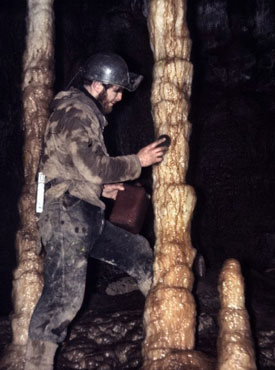
In January, 1965, the British Aircraft Corporation Pot-Hole Club reported to the Council of Northern Caving Clubs that the longest Colonnade in Lancaster Hole was broken transversely, leaving a stump 3' 6" high and seven fragments. There was no apparent movement of either the roof or floor of the chamber.
The Royal C.A.T. C.P.C. (Salford) and the Happy Wanderers C.P.C. decided to attempt to re-erect the column and received permission to descend Lancaster Hole on the 27th February, 1965.
It seemed likely that the reconstruction would not be too difficult since it was probable that the fragments would balance on top of each other without the need for splints. However, thus placed, the pieces would not be very stable since the Colonnade is 15' long and only 5" diameter on average, and so an adhesive was required to secure the joints. It was decided that probably the best adhesive to use would be a resin of the epoxy type.
Ciba Ltd., who manufacture "Araldite" adhesives, were approached and their advice sought. They recommended the use of Araldite GY252 (a low viscosity epoxy resin) in conjunction with hardener X83/144 (a low viscosity liquid). At temperatures approaching 0°C epoxy resin systems are relatively unreactive and usually take many hours to gel and finally cure. However, hardener X83/144 has been developed for use at ambient temperatures within the range 0°C - 10°C. Within this range systems based on the hardener X83/l44 will gel in 2 - 6 hours, depending on bulk and temperature, and will cure at the same rate as normal epoxy resin.
To quote the Araldite instruction sheet No. M23a, "Repairs to damaged concrete can therefore be made with this system at low ambient temperatures, so that minimum delay and inconvenience are experienced."
A point of great importance in the use of this system in a cave is that curing is unaffected by high relative humidities.
We were pleased to receive free samples of both the resin and hardener. In order to obtain a good bond between the fragments it was important to ensure that the faces to be joined were completely free of moisture prior to the application of the resin mixture.
Ciba Ltd. recommend heating with a blow lamp in the case of concrete, but a method which was found to be very efficient and convenient in the present application was to "paint" the wet surfaces with acetone. This solvent removed all the water from the surface and dried within a few seconds of application. (N.B. Acetone is highly inflammable and had to be kept away from the naked flames of acetylene lamps). It was found that after this treatment the adhesive "took" readily to the surfaces to be joined.
After assembling the column on the floor and scrubbing the pieces (which were subsequently handled using clean gloves) with scouring powder, the fragments were dried, "glued", and fitted into position. Since the pieces weighed from 20 - 56 lbs., a block and tackle was used to raise them to the top of the Colonnade. A sheet of polythene was held over the column to prevent drips from the roof wetting the prepared surfaces.
The exact positioning of the fragments was found to be simple.
 As was anticipated, the use of splints was not necessary except on the bottom two joints; the column was exactly vertical. It was found not to be necessary to wait for one joint to set before commencing the second joint. The entire operation took nine hours. A photographic record was made, which includes close-up photographs of the end sections of the fragments.
As was anticipated, the use of splints was not necessary except on the bottom two joints; the column was exactly vertical. It was found not to be necessary to wait for one joint to set before commencing the second joint. The entire operation took nine hours. A photographic record was made, which includes close-up photographs of the end sections of the fragments.
D. Brandon.
16th March, 1965.
This article was originally published in The Cave Research Group Newsletter No. 95. It is reproduced here by kind permission of Derek Brandon.
I had taken a hack saw down to liberate a length of the steel ladder from the bottom of the entrance pitch of Lancaster Hole to facilitate working higher up as the Colonnade when it was re-assembled. Some rungs were cut out to serve as temporary splints between the lower sections.
Each Colonnade was joined to the roof by a straw so I took a suitable piece of straw stalactite of the required length and diameter from somewhere where it would not be missed and carefully glued it in position. It is still there.
I took a pot of my wife’s soup down which caused a lot of fog when it was re-heated on a fire of acetone! There was no draught.
Everyone was delighted with the days work and many returned a week or so later to check everything out.
Derek Brandon ex YRC, NPC and RCATS clubs